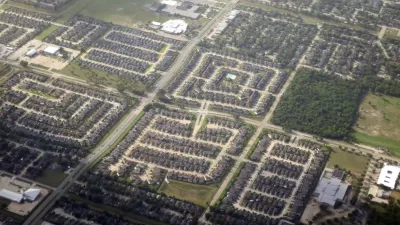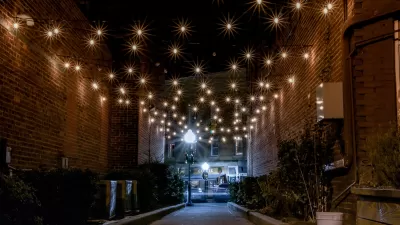Rising energy prices and falling home values are bringing many exurban dwellers closer to the city core. In this commentary, Keith Schneider argues that central cities and inner-ring suburbs need to work with each other to stay afloat.
"If the half century after World War II was the great age of the suburb, the first half of the 21st century is unfolding as the era of a stronger, more cohesive American citistate of combined center city and much more urban suburbs. Today's economy, politics, and culture mirror that shift. The nation's survival - our sustainability - will depend on it."
"But even as downtown, neighborhoods and smart suburbs start to coalesce, they need to move - quickly and courageously - to assure they'll become success points of a new American Dream."
"More than $200 billion in private and public capital needs to be invested over the next decade to build rapid transit for our metro regions, plus regional high-speed rail lines to connect them. Maximizing energy efficiency in community design, and in buildings and homes, is essential to cope with the energy crisis and address global warming. And we need new zoning to locate people and businesses and shopping and schools alongside each other, something that's now actually illegal in many American communities (and critical if we're to promote biking and walking and combat our alarming obesity epidemic)."
FULL STORY: New American Narrative: Strong Cities, Suburbs Allied?

Study: Maui’s Plan to Convert Vacation Rentals to Long-Term Housing Could Cause Nearly $1 Billion Economic Loss
The plan would reduce visitor accommodation by 25,% resulting in 1,900 jobs lost.

North Texas Transit Leaders Tout Benefits of TOD for Growing Region
At a summit focused on transit-oriented development, policymakers discussed how North Texas’ expanded light rail system can serve as a tool for economic growth.

Why Should We Subsidize Public Transportation?
Many public transit agencies face financial stress due to rising costs, declining fare revenue, and declining subsidies. Transit advocates must provide a strong business case for increasing public transit funding.

How to Make US Trains Faster
Changes to boarding platforms and a switch to electric trains could improve U.S. passenger rail service without the added cost of high-speed rail.

Columbia’s Revitalized ‘Loop’ Is a Hub for Local Entrepreneurs
A focus on small businesses is helping a commercial corridor in Columbia, Missouri thrive.

Invasive Insect Threatens Minnesota’s Ash Forests
The Emerald Ash Borer is a rapidly spreading invasive pest threatening Minnesota’s ash trees, and homeowners are encouraged to plant diverse replacement species, avoid moving ash firewood, and monitor for signs of infestation.
Urban Design for Planners 1: Software Tools
This six-course series explores essential urban design concepts using open source software and equips planners with the tools they need to participate fully in the urban design process.
Planning for Universal Design
Learn the tools for implementing Universal Design in planning regulations.
City of Santa Clarita
Ascent Environmental
Institute for Housing and Urban Development Studies (IHS)
City of Grandview
Harvard GSD Executive Education
Toledo-Lucas County Plan Commissions
Salt Lake City
NYU Wagner Graduate School of Public Service




























